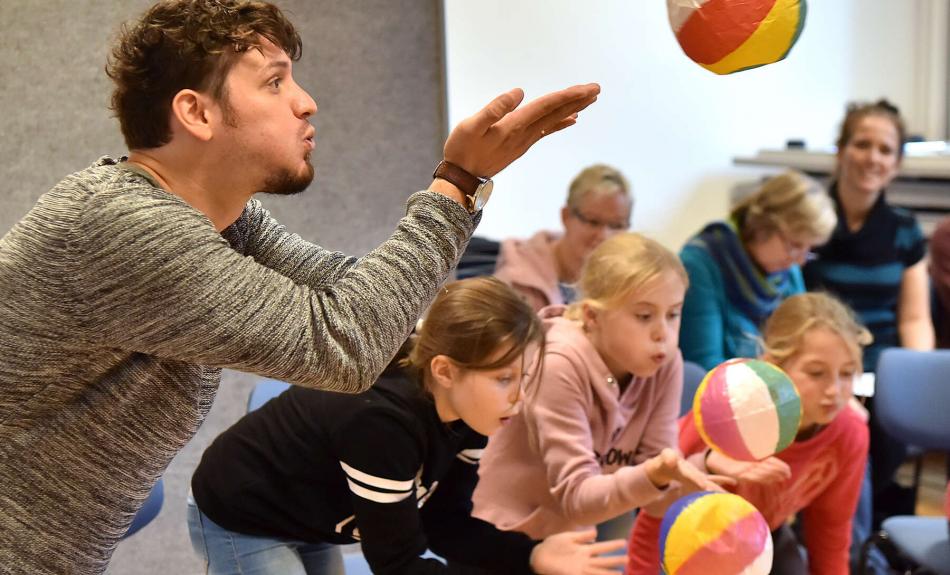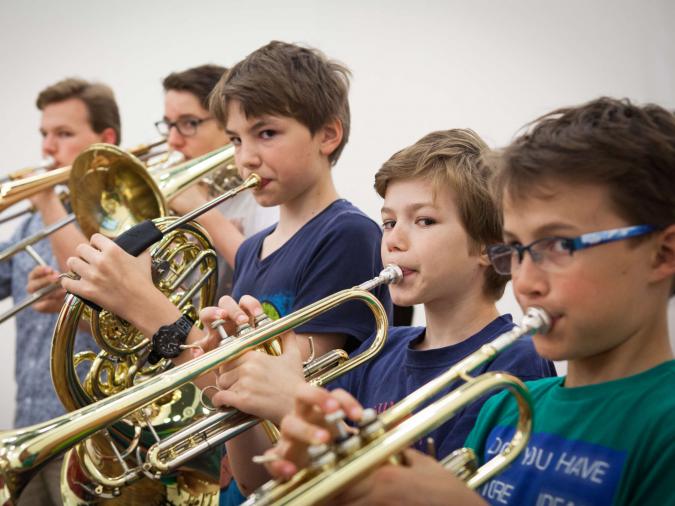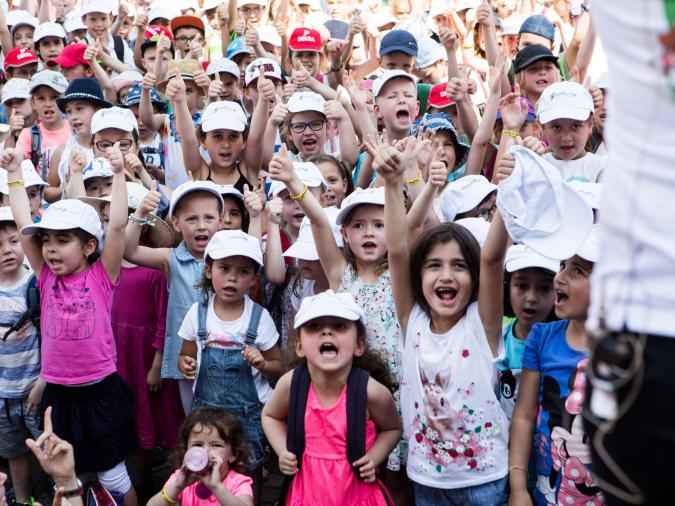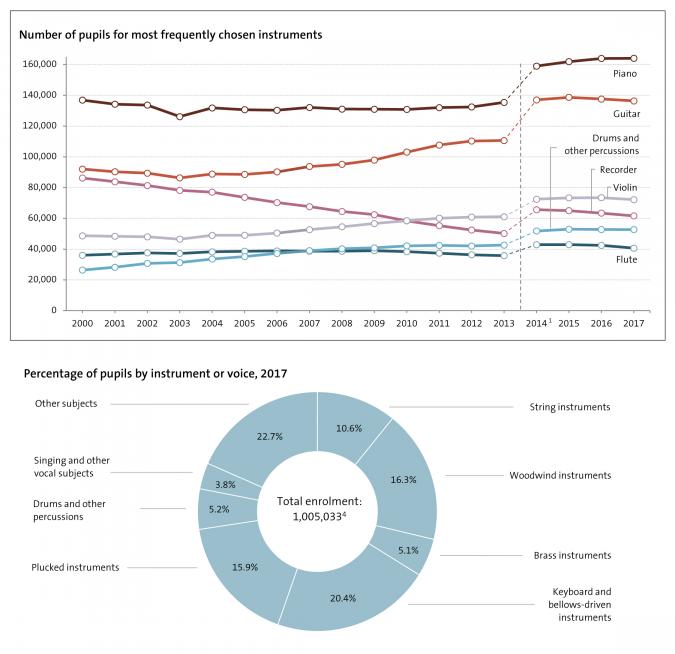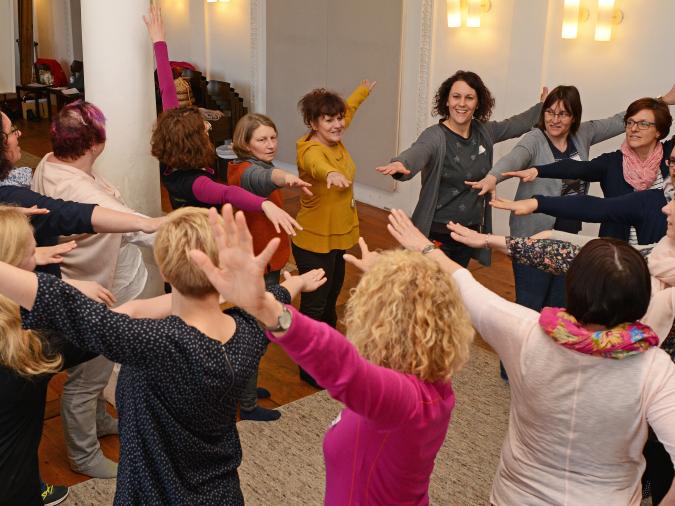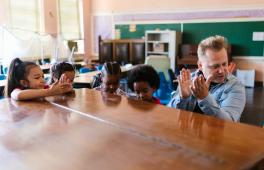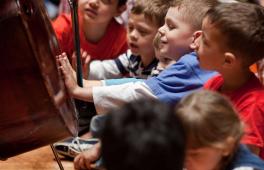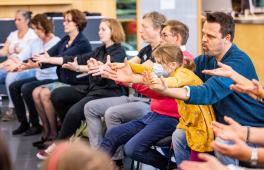Besides music instruction in Germany’s state school system, music education outside state schools is a field in its own right, with its own goals, tasks, structure and institutions. While music instruction in schools provides what amounts to mandatory general musical training for everyone, music education outside school is fundamentally voluntary. It also offers a wide range of individual options for taking an active part in music-making. Quite often the instruction centres on learning an instrument, but great importance is also attached to ensemble playing. Recent developments have cast doubt on the strict separation of music education inside and outside state schools. For one thing, many of Germany’s state schools offer instrument lessons in cooperation with public music schools and freelance teachers. For another, they also provide opportunities for playing music in a very wide range of ensembles. This was the case even before 2003, when the federal government began to promote the establishment of all-day schools. Nonetheless, the interweaving of music education inside and outside the state school system has doubtless profited from the changes this entailed.
In principle, music education outside state schools should give people of all ages an opportunity to develop their musical abilities and skills according to their individual interests and to integrate them into cultural life. This calls for broad-based support with offerings that are both convenient to access and readily affordable. But especially interested and gifted children and young people must also be offered training at a high level, providing future professionals with crucial groundwork before they enter college.
The range of offerings available outside the German school system is broad and varied: public music schools can be found all across the country; private music schools have also emerged, as have freelance music teachers who offer private instruction on the open market; and day care centres for pre-school children are also gaining in importance. Moreover, 3.7 million people of all ages are involved in amateur music making in secular or church associations, which often provide lessons and support for their young members. Many art schools for young people, such as those in the dance and new media sectors, also include musical components, offering interdisciplinary possibilities for creative work in courses, workshops or other projects. Music courses are offered specifically for adults and families at adult and family education centres. And finally, more than 300 youth orchestras have joined together in Jeunesses Musicales Deutschland, providing many incentives for ensemble playing in their initiatives and projects.
There is a broad consensus in German society on the value of music education outside the school system, since the importance of its role in personal growth and cultural involvement is basically beyond question. Its significance can be seen not least of all in the activities of theatres, concert halls and orchestras, which are increasingly addressing young audiences. Special inducements are provided by the programmes of the German Music Council and its member organisations. The council’s nationwide competition ‘Jugend musiziert’ (Youth Makes Music) has been an established feature of the music scene for almost 50 years. The competition is held at regional, state and national levels, with from 15,000 to 25,000 young people taking part every year. Also worth mentioning are the national competitions ‘Jugend jazzt’ (Youth Plays Jazz) and ‘Jugend komponiert’ (Youth Composes). Last but not least, the German Music Council supports numerous music ensembles designed to foster up-and-coming young talent, such as the National Youth Orchestra of Germany and the state youth orchestras and choruses.
‘Pre-school and day care centres have a special opportunity to integrate music organically into the child’s everyday life.’
Die außerschulische musikalische Bildung wird grundsätzlich von einem breiten gesellschaftlichen Konsens getragen, denn ihre Bedeutung für die Entwicklung der Persönlichkeit und eine kulturelle Teilhabe stehen außer Zweifel. Sie zeigt sich nicht zuletzt in den Aktivitäten von Theatern, Konzerthäusern und Orchestern, die sich verstärkt auch dem jungen Publikum zuwenden. Besondere Anreize werden zudem durch spezielle Angebote des Deutschen Musikrats und seiner Mitgliedsorganisationen gesetzt: Seit über 50 Jahren ist der bundesweite Wettbewerb „Jugend musiziert“ etabliert, der auf Regional-, Landes- und Bundesebene ausgetragen wird und an dem jährlich zwischen 15.000 und 25.000 junge Menschen teilnehmen. Weiter sind die Bundesbegegnung „Jugend jazzt“ und der Wettbewerb „Jugend komponiert“ zu nennen sowie schließlich Ensembles zur Förderung des musikalischen Nachwuchses wie die Landes- und das Bundesjugendorchester oder die Landesjugendchöre.
Nurseries and day care centres
Outside the home, children of pre-school age are most likely to encounter music in day care centres or nursery schools, where ‘training in music and art’ (‘musische Bildung’, to use the wording of the joint resolution of the Youth Ministers Conference and The Standing Conference of the Ministers of Education and Cultural Affairs) has become firmly anchored as an obligatory educational area in all of Germanys federal states. [1] Arts education in general, and music in particular, are central in varying degrees to the newest educational plans of Germany’s states. In addition to the dedicated field of music education, music can also be found as a cross-sectional task that can be fruitful in combinaton with other areas of education, such as language, cognition, sense perception, body movements and emotions. The core aim is to appeal to a child’s senses and emotions as well as fostering creativity and imagination. [2] Pre-school and day care centres have a special opportunity to integrate music organically into the child’s everyday life.
Accordingly, music is also meant to play a role at vocational colleges, where early education workers are trained, and at institutions of higher learning, which have begun to offer fields of study in this area, particularly since singing is a preferred activity in kindergartens. [3] As a result, music is usually included in the curricula of Germany’s states as an educational topic. It is treated as a subordinate field of study under a name such as ‘Professional Design of Social Work in Fields of Education’, or something similar. Usually the number of units devoted to music is left open. [4] Viewed as a whole, training in music often fails to meet the qualification standards desired by the responsible institutions.
The importance of cultural education in early childhood and the deficiencies of music education in kindergartens have by now entered public awareness on many levels. This is apparent in the state educational plans cited above, in a series of projects aimed at establishing music in day care centres, and in appeals and position papers issued by professional associations and political bodies. [5] There has also been an increase in attempts to counter the dearth of musical stimuli in day care centres through continuing education projects for child care workers. According to a survey by the Bertelsmann Foundation, more than 60 per cent of people working in kindergartens consider themselves middling to poorly trained in music education and perceive a correspondingly great need for further training. [6] This is one reason why foundations often become involved in fostering music at child care institutions. Recently some pre-school facilities have established themselves as ‘music kindergartens’. Some are also accompanied with research or concept development projects of the sort that Daniel Barenboim has introduced in Berlin’s Musik Kindergarten and in the MusikKinderGartenWeimar. Germany’s professional associations have likewise displayed great commitment to cultural education in early childhood.
Often teachers from music schools or the freelance sector will give instruction in kindergartens, though this is sometimes rendered impossible by practical limitations. Even so, roughly one out of every ten day care centres now cooperates with a public music school. [7]
Public music schools
Public music schools play a key role among the providers of music education outside the state school system. As non-profit institutions, they perform educational, cultural, socio-political and youth-oriented tasks and have become permanent fixtures in Germany’s educational landscape.
Today 930 public music schools are members of the Association of German Music Schools (Verband deutscher Musikschulen, or VdM). [8] The central values of the VdM are to enable everyone to participate in music, to provide continuity and common educational experiences, to secure the organisational structure of the course offerings, to take part in social developments and to promote variety in musical culture. [9] Many public music schools offer instruction at various branch locations, so that we can assume a total of some 4,000 locations in Germany. They are scattered across all the German states, although there are variances in regional distribution. The locations are on average ten kilometres apart, allowing for near blanket coverage everywhere in the country, including rural regions (see Fig. 1).
Schools seeking to join the VdM must fulfil numerous quality criteria. This means that, for the state and for parents, membership guarantees a certain level of expertise. Teachers must have studied music education or have a comparable level of qualification, and school directors must have a degree in music. The VdM develops curricula, hosts continuing education programmes and congresses, and advises the schools in its membership. A number of the schools have developed additional quality assurance programmes.
In the past, public music schools have often proved open to new subjects and have kept abreast of developments in society. For instance, work during the final two pre-school years in what is called ‘early music education’ (‘Musikalische Früherziehung’) has become a set part of the schools’ offerings, as has the teaching of younger children and their caregivers. Since the 1990s, the VdM has also devoted more attention to adult beginners and people returning to music after a long absence. Today some 10 per cent of those enrolled at public music schools are 19 years or older (see Fig. 2). Demographic changes have also led to a greater focus on music education for seniors. At present 1.8 per cent of the VdM’s clientele are above the age of 60. Standard publications expressly emphasise the importance of a sufficient number of qualified offerings in this area.
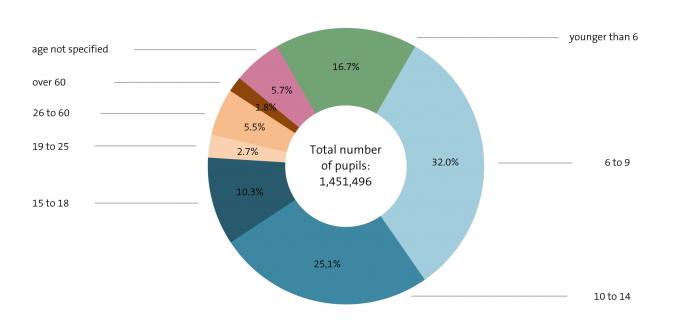
Since the early 1980s the VdM has also made a concerted effort to integrate children of immigrants. Most recently the association, faced with population changes, has launched a project called ‘Musikalische Bildung von Anfang an’ (Music Education from the Very Beginning), which deals with concepts of intercultural music education and addresses families from differing cultural, linguistic and social backgrounds. More than half of the music schools also offer instruction for the disabled. The VdM runs its own continuing education programme to train music teachers in this area. Finally, the music schools of the VdM have initiated many offerings in connection with refugees. [10]
The variety of musical genres taught at music schools has constantly grown. Popular music has long been a regular part of music school curricula. Special courses of study at university level offer degrees in teaching popular music. In addition to instruments such as the electric guitar, bass, saxophone and keyboards, schools also have ensembles playing rock, pop or jazz. Schools in rural areas will, as a matter of course, form ensembles or offer instruction in instruments particular to folk music. Today instruments native to the folk traditions of other countries, such as the Turkish bağlama, can also be studied at many music schools.
Structure
For public music schools, the VdM has developed a compulsory structural plan, which was last updated in 2009. The plan divides studies into four levels: elementary/basic, lower, middle and advanced. The elementary/basic level, which has its own educational plan, [11] presents fundamental instruction that is not only meaningful in its own right, but can also serve as the basis for later specialisation. It is noteworthy for its broad and diverse range of offerings: songs and vocal improvisation cover the area of singing; the instrumental category is represented by free and structured playing of various instruments, usually small percussion or what are called ‘Orff instruments’, named after the German composer and music educator Carl Orff; and the category of body movement includes dance, improvisational movement and body percussion. Closely interlinked with these categories are perception and experience, which range from stimulating the senses and listening to highly diverse pieces of music, to experiencing instruments that children might later learn to play. There is also a place in the programme for thinking about music, e.g. sharing musical impressions or discussing musical structures and notation. Finally, music is linked to other forms of expression, such as theatrical scenes, rhythmic declamation, visualising music through pictures or building instruments. According to the educational plan, instrument lessons take place on the lower, middle and advanced levels. In addition to individual lessons, the lower level in particular also provides for group or classroom instruction.
According to estimates from the VdM, more than half of all music schools offer a ‘college preparatory course’ for pupils who want to study music at the university level. This programme offers classes in the pupil’s primary instrument as well as instruction in a second instrument and preparation for the aptitude test in music theory and ear training. On average, a quarter of first-semester music students at university have completed such a course of study. In addition to the levels of instruction, the VdM’s structural plan also includes compulsory ensemble work and complementary subjects. The VdM considers ensemble work in particular to be an indispensable mainstay of public music schools, which often distinguishes them from private instruction. Every music school currently offers an average of 20 ensembles. They also offer a broad spectrum of complementary subjects, such as ear training, music theory, or music and movement. The curriculum is rounded off with projects and special events. In fact, VdM music schools have on average two such events per week of instruction, including many events from other institutions with which the music school is connected. The structural plan also calls for joint projects with other educational bodies in the municipal landscape.
Co-operative programmes
As in day care centres, co-operative programmes between music schools and state schools have increased in overall importance, if only because of the growing amount of time pupils now spend at school. According to figures from the VdM, roughly one in every three co-operative programmes is linked to a primary school, with the number reaching 4,300 at present, or even more in connection with kinder-gartens and day care centres. Four of every five music schools in the VdM thus work together with primary schools. Co-operative programmes with other kinds of state schools are now maintained by 25 to 45 per cent of the VdM’s members. Co-operations with public music schools largely centre on the elementary/basic level, classroom instruction and various projects at all-day schools. At the elementary/basic level, in addition to the joint programmes that 65 per cent of public music schools maintain with day care centres and nurseries, new models of co-operation with primary schools have opened up fresh perspectives (see Fig. 3 in ‘Music in Germany’s State Education System’). One particularly vigorous co-operation is the so-called ‘JeKits’ programme (short for ‘Jedem Kind Instrumente, Tanzen, Singen’, or ‘Instruments, Dancing and Singing for Every Child’). The aim is to enable every primary school student to learn to express himself or herself in music, regardless of the financial means of the parents. The programme was initiated in North Rhine-Westphalia as part of the Ruhr area’s year as European Capital of Culture in 2010, when it was called ‘JeKi’ (‘Jedem Kind ein Instrument’, or ‘An Instrument for Every Child’) and was financed with public and foundation funds. Since the 2015-16 academic year each participating school chooses one of three main points of emphasis: singing, dancing or the playing of instruments. In the first year, group instruction in music or dance is compulsory in every class-room. The second year then offers lessons in the chosen form and participation in a related ensemble.
In the meantime similar programmes have been adopted, with regional variations, by various communities and states, and group instruction in primary schools seems to have become a new field of activity for both music school and freelance music teachers. Besides JeKi in Hamburg, Hessen and Saxony, other programmes focusing on instrument instruction or singing also exist in primary schools. [12]
The subsidised development of all-day schools in Germany has resulted in new organisational forms, tasks and student groups for music schools. Framework agreements between the VdM and the relevant state ministries are aimed at ensuring the quality of elective music courses at all-day schools and establishing VdM member schools as preferred partners in providing them. [13] This kind of co-operation is especially suited for musical ensembles, complementary courses, classes in elementary music-making and special projects. Besides permanent co-operations, public music schools are also intent on networking with other municipal institutions, such as libraries, museums, churches, youth centres and theatres.
Students and teachers
Over 1.4 million pupils currently attend Germany’s public music schools, including more than two-thirds between the ages of six and 18 (see Fig. 2). A significant percentage also falls on those under six years of age (17 per cent) who take advantage of the many offerings in early music education. Roughly 10 per cent of the pupils are adults.
The instruments taught most frequently at Germany’s public music schools are, in descending order, piano, guitar, violin, recorder, percussion and flute (see Fig. 3). Meanwhile more than 45,000 children in state schools take part in wind classes conducted via music schools, and almost 14,000 in string classes. In addition there are 24,000 chorus and band classes, and classroom instruction is also given on other instruments. Recent years have witnessed an overall growth in classroom instruction.
More than 39,000 trained teachers teach at Germany’s public music schools, including some 20,000 on permanent contracts and another 19,000 as freelancers on a pro rata basis. Some 13 per cent of those on permanent contracts are employed full-time. This means that the great majority work part-time. However, the absolute number of public music school teachers is probably slightly lower, as those who teach at more than one school will appear multiple times in the statistics.
Under VdM guidelines, teachers and directors at music schools are, for the most part, supposed to be officially employed by the school’s financing entity, and thus subject to the wage and salary agreements applicable to civil servants. The per centage of teachers paid in this way varies from one federal state to the next between almost 7 per cent (Berlin) and nearly 60 per cent (Bavaria), with a nationwide average of almost 40 per cent. A good 11 per cent are employed at a different wage scale. Almost half the teachers at public music schools work on a pro rata basis as freelance employees. [14] Of these, a good half are paid between €19 and €24 per 45-minute lesson. Roughly one teacher in five receives less than that, and roughly one in four more. Considering that between 80 and 90 per cent of teachers employed at music schools work part-time, it is safe to assume that many of them have second jobs, sometimes at other music schools, in order tosecure their livelihood.
Financing
In legal terms, the operation of facilities for music education outside the state school system is a voluntary expense of the public sector. Roughly half of the costs incurred by public music schools is paid from the public purse. The largest portion is provided by local authorities, while the portion borne by state governments varies widely from state to state, ranging in the non-city states from 1 per cent to more than 19 per cent. A few states have legally binding guidelines for the accreditation and funding of music schools, so that state funding is linked to VdM criteria.
About two-thirds of VdM schools are operated by governments at the municipal level. One-third are operated by associations but still receive substantial public funding. According to VdM figures, the overall budget for VdM music schools most recently amounted to roughly €1 billion. About half the costs were covered by tuition fees. These in turn vary widely, amounting on average to roughly €85 per month for 45-minute lessons of individual instruction. According to the VdM membership criteria, there must be an official schedule of fees that allows for discounts for socially disadvantaged pupils.
Private music schools
In addition to publicly funded music schools, Germany also has a very wide range of private or independent music schools. These include both large companies and franchise operations, some of which train their own teachers or use their own teaching materials.Many music shops also offer instruction on various instruments. Finally, there are private music teachers who run small schools at their own initiative, usually with a single location and sometimes focused on a specific genre (e.g. a genre of popular music) or a specific instrument. Such schools thus differ markedly in structure from public music schools, for only in Bavaria is the term ‘music school’ protected and subject to particular stipulations. Since private music schools must be economically viable to survive, they must take in more money than they spend. This is in principle true even when small subsidies are provided by a local authority, perhaps because it does not operate a music school of its own.
The German Association of Free Music Schools (Bundesverband der Freien Musikschulen, or bdfm) is a consortium of private music schools with agreed standards for certified membership. The first criterion for full membership is that a school must not have, or be linked to, any purpose outside of teaching, for instance the selling of instruments. Other criteria concern contractual agreements, teaching space, involvement in public music life and teacher qualifications, though here a standard music degree is not mandatory. There are state groups or associations of the bdfm in many German states, with a total of roughly 340 schools with 127,000 pupils and 6,300 teachers in 2016. These figures are estimates based on a voluntary survey conducted by the bdfm. [15] Although the response rate was only 36 per cent, the findings shed a certain light on the membership of the bdfm. Like the VdM schools, a large number of independent music schools co-operate with state schools or other institutions, such as day care centres, music clubs and church congregations, as well as choruses, senior citizen facilities and adult education centres, thereby incorporating an additional 31,000 pupils into their teaching activities.
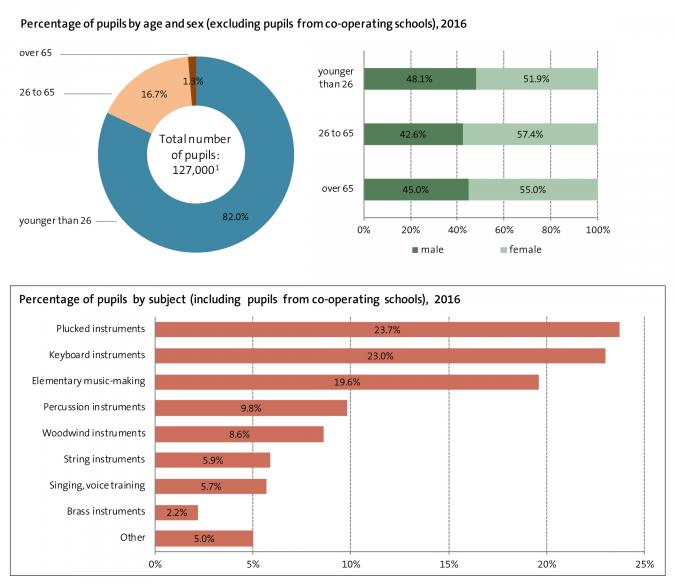
Compared to VdM music schools, the members of the bdfm have far fewer teachers on permanent contracts. They are found in only some 7 per cent of the schools, whereas more than 90 per cent employ teachers exclusively on a pro rata basis. Of the latter, a good 40 per cent earn up to €18 per lesson, another 40 per cent between €18 and €24, and every sixth pro rata teacher more than €24. The fees earned for group instruction and elementary music-making are higher.
The great majority of bdfm music schools are either one-person businesses (68.3 per cent) or organised as non-profit limited liability companies (9.8 per cent), civil-law partnerships (6.5 per cent), non-profit associations (5.7 per cent) or, more rarely, for-profit companies (3.3 per cent) or for-profit associations (1 per cent). All in all, 15.5 per cent of the member schools have non-profit status. Only about a quarter of bdfm schools receive subsidies from the public purse.
Freelance music teachers
Freelance music teachers have always been a mainstay of music education outside Germany’s state school system. The very fact that a good fifth of the participants in the ‘Jugend musiziert’ (Youth Makes Music) competition on the national level are taught by private music teachers unconnected with music schools bears witness in some cases to their high qualifications. [16] They teach at all levels, from beginners to pupils preparing for university studies, and in some cases they even work with professional musicians. Some of them are able to adapt to pupils’
scheduling needs or their desire for sporadic tuition. Often they are also able to respond to a student’s need for tuition at home. By joining together, freelance music teachers can offer an enlarged range of tuition, such as lessons in ensemble playing. Sometimes schools or churchcongregations organise private tuition and provide the necessary rooms for it to take place. In general, private teachers contribute to decentralised and customer-focused music tuition. It should also be borne in mind that not every pupil can find a place in public music schools, which could have accommodated 64,000 additional pupils in 2016 if the necessary resources had been available. [17]
Freelance music teachers often put together patchwork careers made up of private lessons, fee-based teaching at music schools, concert appearances and the like. If they can prove that most of their income comes from freelance work in music, they may also apply for admission to Germany’s social insurance scheme for artists (Künstlersozialkasse, KSK). The KSK pays half of a member’s social welfare contributions, an amount normally paid by the employer in Germany. Since private music teaching does not necessarily require formal qualifications, many freelance music teachers join the German Musicians’ Association (Deutscher Ton-künstlerverband, DTKV), which is in turn divided into statewide organisations. Membership requires proof of professional qualifications and, as such, serves as a seal of commendation. The DTKV negotiates framework contracts with insurance companies, organises conferences and courses, and functions as an advocate for its members in the political arena. For example, its governing board and state subsidiaries are taking part in the debates on all-day schools.
The financial circumstances of freelance music teachers can be quite precarious. Some of them have other professional or private priorities that restrict their activities to a relatively small number of pupils. But many are intent on expanding the number of lessons they give. Some succeed in establishing a good reputation in their catchment area, allowing them to attract regular pupils and achieve earnings comparable to those of permanently employed music school teachers. But most earn far less than their staff colleagues. According to a survey of music school teachers, conducted for the third time by the German trade union ver.di in 2017,
lesson fees represent the sole or main source of household income for nearly a third of all freelance teachers employed at music schools. [18]
Amateur music-making
Across Germany there are more than 22,000 secular amateur choirs and some 20,000 instrumental ensembles organised in associations. [19] Numerous music associations independently organise and run instruction for their young members. Special courses exist that can lead to a license as a training supervisor at various levels. The National Union of German Music Associations (Bundesvereinigung Deutscher Musikverbände, BDMV) provides guidelines for the training of musicians (among other things), holds contests and awards certificates of achievement.
Its youth organisation, the Young German Wind Players (Deutsche Bläserjugend), has children and young people up to the age of 27 in its wind ensembles and marching bands. Instrument training is offered by its own members, freelance teachers or music schools. The examinations (referred to as D1, D2 and D3) lead to bronze, silver or gold medals and include recital pieces at pre-defined levels of difficulty, various exercises and written assignments related to music theory. Similar courses and examinations are offered by the Federation of German Mandolin and Guitar Players (Bund Deutscher Zupfmusiker, BDZ), the German Zither Music Federation (Deutscher Zithermusik-Bund, DZB) and the German Harmonica Association (Deutscher Harmonika-Verband, DHV). Finally, amateur music associations train select pupils from the age of 16 to be so-called ‘music mentors’ for youth work in their associations. Amateur music associations often enter into co-operative training arrangements with federal and state music academies, which offer a broad spectrum of courses all over the country.
Those interested in musical activities and developing their musical skills and abilities can also find a variety of possibilities in church congregations. Directing choirs and ensembles has been the responsibility of church musicians since time immemorial and forms an essential part of their training. Here pastoral work interlocks with music teaching and artistic aspects. There are almost 34,000 church choirs in the country, including numerous children’s and youth choirs, all of which are essential to church worship and parish life. Often there are also open singing circles for seniors and, finally, church instrumental ensembles. The brass choirs associated with the Lutheran church enjoy a particularly rich tradition. Altogether, more than 850,000 people in Germany sing or play in church ensembles, most of them in choirs. Children and young people account for more than one-quarter of the members of church choirs and instrumental groups. Many churches also organise special educational courses on music.
Adult education and family education centres
Besides music schools, Germany’s state-subsidised adult education centres (Volkshochschulen) can also be community providers of music instruction. These centres are mandated to offer courses of all kinds to adults. Rather than offering fields of study in the manner of a university, they provide various personalised forms of continuing education. For instance, participants can learn a language, receive an introduction to certain areas of computer use or make up part of a missing school degree or leaving certificate. People book the instruction, including in music, as a course for one semester or a pre-set number of lessons. Rather than being salaried employees, the teachers are paid on a pro rata basis.
In terms of music performance, the centres offer such things as group musicmaking and instrument lessons. The number of performance courses on offer has remained constant for years and amounts to nearly 12,000 annually throughout the country. On average, the courses cover 17.4 lessons of 45 minutes each. Approximately 1,400 music theory courses, usually for slightly larger groups, are also offered at adult education centres. [20]
Finally, intergenerational opportunities in particular, such as parent-child groups, can be found at family education centres. These are basically similar to adult education centres. They are often run and/or funded by churches, associations or local governments and generally offer courses of limited duration. The courses cover a variety of subjects: health, parenting, life crisis management, continuing education in social pedagogy, but also fields of creativity. For instance, depending on
the centre, one might find courses in dancing, guitar or groups for elementary music-making. Family education centres seek to support families with their course offerings and to contribute to their personal guidance and education. One clear indication of their social mission is that the courses are usually inexpensive. Thus, music plays a role in many of these institutions as an opportunity to develop an individual’s creative potential and to enrich family life.
Conclusion
Germany has a wide range of opportunities for all age groups in music education outside its state school system, from parent-child groups working with children as young as infants, to pre-school and schoolage instruction and programmes aimed specifically at adults, including the elderly. Private providers complement the course offerings of public institutions. Particularly in rural areas, the duties of music education outside the schools often fall to amateur music associations. Public and private music schools, with their respective standards, are nonetheless
widespread throughout all the German states. In short, people in Germany have access to a wide-ranging network of options for musical activities and for acquiring and developing their individual skills and abilities.
Footnotes
Gemeinsamer Rahmen der Länder für die frühe Bildung in Kindertageseinrichtungen: Beschluss der Jugendministerkonferenz vom 13./14.05.2004 / Beschluss der Kultusministerkonferenz vom 03./04.06.2004, online at http://www.kmk.org/fileadmin/Dateien/veroeffentlichungen_beschluesse/2004/2004_06_03-Fruehe-Bildung-Kindertageseinrichtungen.pdf (accessed on 25 September 2018).
See the educational plans at https://www.bildungsserver.de/Bildungsplaene-der-Bundeslaender-fuer-die-fruehe-Bildung-in-Kindertageseinrichtungen-2027-de.html (accessed on 28 November 2018).
Peter Brünger, ‘Singen im Kindergarten’, in Andreas Lehmann-Wermser and Anne Niessen, eds., Aspekte des Singens: Ein Studienbuch (Augsburg, 2008), pp. 65-77.
See also Bundesarbeitsgemeinschaft der öffentlichen und freien, nicht konfessionell gebundenen Ausbildungsstätten, Länderübergreifender Lehrplan Erzieherin/Erzieher – Entwurf vom 01.07.2012, online at https://www.bildungsserver.de/onlineressource.html?onlineressourcen_id=50329 (accessed on 26 September 2018). [New: https://www.boefae.de/wp-content/uploads/2012/11/laenderuebergr-Lehrplan-Endversion.pdf, accessed on 15 March 2022]
Bundesvereinigung Kulturelle Kinder- und Jugendbildung, ed., Spiel und Kunst von Anfang an: Kulturelle Bildung für junge und sehr junge Kinder: Positionen und Ziele (Remscheid and Berlin, 2016), online at http://miz.org/downloads/dokumente/798/2016_BKJ_Positionspapier_Spiel_und_Kunst_von_Anfang_an.pdf (accessed on 26 September 2018)
See also Patricia Brinker et al., Musikalische Bildung in der Qualifizierung für Kindertageseinrichtungen in Nordrhein-Westfalen, ed. Kompetenzzentrum Frühe Kindheit Niedersachsen der Stiftung Universität Hildesheim im Auftrag der Bertelsmann Stiftung (Hildesheim, 2010), online at http://www.miz.org/dokumente/studie_bertelsmann_kindertageseinrichtungen.pdf (accessed on 26 September 2018).
Autorengruppe Bildungsberichterstattung, ed., Bildung in Deutschland 2012: Ein indikatorengestützter Bericht mit einer Analyse zur kulturellen Bildung im Lebenslauf (Bielefeld, 2012), pp. 175-87, esp. p. 177, online at https://www.bildungsbericht.de/de/bildungsberichte-seit-2006/bildungsbericht-2012/bildung-in-deutschland-2012 (accessed on 26 September 2018).
All figures listed below regarding public music schools are taken from the statistics of the Association of German Music Schools (Verband deutscher Musikschulen, VdM), which updates and publish es them at regular intervals. See Verband deutscher Musikschulen, ed., Statistisches Jahrbuch der Musikschulen in Deutschland (Bonn, 2018).
Verband deutscher Musikschulen: Grundsatzprogramm [2016], online at http://miz.org/downloads/dokumente/786/2016_VdM_Grundsatzprogramm.pdf (accessed on 26 September 2018)
See also the MIZ’s project database at http://integration.miz.org, which currently lists more than 350 initiatives, including offerings from public music schools (accessed on 30 November 2018)
Verband deutscher Musikschulen [Association of German Musik Schools], ed., Bildungsplan Musik für die Elementarstufe/Grundstufe (Bonn, 2010).
See e.g. https://www.musikschulen.de/kooperationen/allgemeinbildende-schulen/index.html (accessed on 24 September 2018)
See https://www.musikschulen.de/kooperationen/allgemeinbildende-schulen/rahmenvereinbarung-richtlinien/index.html (accessed on 27 September 2018).
For some time a debate has been heatedly conducted on raising the percentage of permanently employed music school teachers. See the VdM’s ‘Stuttgarter Appell’ of 2017.
Bundesverband der Freien Musikschulen: Statistik 2016 (accessed on 29 September 2018). More recent data are scheduled for publication by the bdfm in 2019.
Verband deutscher Musikschulen, Statistisches Jahrbuch der Musikschulen 2017, p. 28.
Ibid., p. 16.
Jürgen Simon, Einkommenssituation und Arbeitsbedingungen von Musikschullehrkräften und Privatmusiklehrern 2017: Ergebnisse der Umfrage der Fachgruppe Musik der ver.di von Juli 2017 bis September 2017, ed. ver.di | Vereinte Dienstleistungsgewerkschaft (Berlin, 2017), online at http://www.miz.org/downloads/dokumente/910/2017_Umfrage-Musikschullehrkraefte_verdi.pdf (accessed on 18 July 2018)
See also Astrid Reimers’s essay on ‘Amateur Music-Making’
See the statistics on music courses offered at adult education centres (Statistik Musikangebote der Volkshochschulen) (accessed on 9 November 2018).
